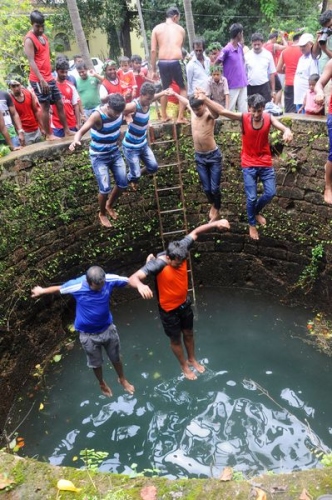
On 24 June, the Catholic Church commemorates the solemnity of St John the Baptist or Sao Joao in the Portuguese language. John the Baptist was born to the temple priest Zachariah and Elizabeth, who are cousins of the Mother of Jesus Christ. Elizabeth miraculously conceived the child in her old age (Lk 1:7), six months before the birth of Jesus (Lk. 1:26).
According to Luke 1, upon hearing of the news of Elizabeth expecting a child, Mary rushed to visit her in a town in Judah. Realising that the Mother of the Messiah had come to visit them, the child in Elizabeth’s womb leaped in joy and she was filled with the Holy Spirit. It is in this background that many jumps in wells to celebrate São João in Goa. The celebration comprises solemnity and local customs.
In the New Testament, the canonical Gospels give an account of John the Baptist, but the synoptic Gospels begin with his ministry as the herald of the coming Messiah (Mk. 1:1-8), his family and miraculous birth (Lk. 1:5-24), and his testimony as one crying in the desert … Look, there is the lamb of God (Jn. 1:19-34).
The Gospel of Mark introduces John as a fulfillment of a prophecy from the Book of Isaiah about a messenger being sent ahead, and a voice crying out in the wilderness. John is described as wearing clothes of camel's hair, living on locusts and wild honey. John proclaims baptism of repentance for the forgiveness of sin and says another will come after him (introduces Jesus) who will baptize with the Holy Spirit.
John baptised Jesus at Bethany on the bank of river Jordan. As Jesus emerges from the water, the heavens open and the Holy Spirit descends on Him like a dove. Then a voice said from heaven, This is my own dear Son with whom I am pleased (Mt. 3:17). This gives Jesus power to establish His ministry.
The São João celebration has evolved over the years in the villages. People eagerly wait for the feast that unites everybody as a family with loads of joy at the peak of the monsoon season. On 23 June, some youngsters beat the Judeu with a coconut stick (piddo), concurrently shouting Judeo, Judeo…. The beating of Judeu perhaps symbolizes the hostility against the Jews, who opposed Christianity.
The day begins with the parishioners attending the Eucharistic celebration to seek blessings. São João is celebrated with great enthusiasm and zest in the coastal villages of Bardez. The Siolim São João Traditional Boat Festival is the most spectacular celebration that attracts revellers from different parts of Goa. The main attraction is the procession of canoes which replicates the entry of the Portuguese merchants in Goa. The theme-decorated canoes portray social issues as the football world cup, nature/environment preservation. They make their way through the Chapora river to the creek opposite the St Anthony church.
After reaching in front of the church, one of the youngsters place a flower-decorated kopel on the cross, light candles, and firecrackers, after which the saude (toast raising) is done. The participants dance to the tune of São João, "São João ghunvtat mure, vaat amka disona, osli feastam vorsak kiteak don pauvti yenna?" Playing of musical instruments like trumpet, madallem, ghumot, etc adds joy to the celebration. The Siolkars and the neighbouring villages participate and the best-decorated canoes win prizes.
When all the canoes arrive, the participants adorned in festive attire and with a kopel of flowers on their head assemble on the stage set up nearby, and a cultural program begins. Sangodd is also a similar celebration that takes place in Baga. At the Saligao church, the Vangodd is held, where the participants share fruits, Goan sweets, sing, and dance to the tune of traditional Goan songs. The intention is to teach the young generations the traditional way of Goan life.
South Goa also showcases the São João celebrations with enthusiasts singing Mandos, and jumping in wells/streams/tollem. Someone would drop a cashew Feni bottle in the well, and there is a rush of revellers to jump and retrieve it. A vast repertoire of music/songs sung/played in the background adds gaiety to the festival. The festivities bring together people from the village, irrespective of religion, young or old. Sliced seasonal fruits like jackfruit, mango, pineapple, and homemade sweets are served to the revellers. These traditions are slowly disappearing due to the growing commercialisation of the feast and migration of many Goan Catholics abroad.
Traditionally, the newly-married daughters of the village return to their maiden home with their husbands and take part in the festivities. The family places decorated Kopels on their heads and welcome them. The sons-in-law are pampered with local delicacies and potent fruits with the good intention that they may be gifted soon with a child.
The sons-in-law either jump/drop coins in the well for the reveller to dive and pick up, if the well is shallow or offer a bottle of feni. Their presence is also a good opportunity for the villagers to interact. From this viewpoint, the feast is known as Zanvoianchem fest. This reminds me of C Alvares song: "Ami Sogle zanvoim vortoutanv, chodda tempan bhetleanv, São João-chem fest mhunnon ami mavoddea aileanv, Mateak him kopelam ghalun udok navonk bhair sorleanv, Aichea dissak voddle ami nokom khuim pauleanv…. São João, São João…"
(The author is a scientist, researches on global climate change issues and is a freelance writer.)